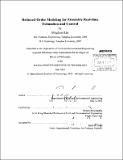| dc.contributor.advisor | Dennis McLaughlin. | en_US |
| dc.contributor.author | Lin, Binghuai | en_US |
| dc.contributor.other | Massachusetts Institute of Technology. Dept. of Civil and Environmental Engineering. | en_US |
| dc.date.accessioned | 2012-10-26T18:07:43Z | |
| dc.date.available | 2012-10-26T18:07:43Z | |
| dc.date.copyright | 2012 | en_US |
| dc.date.issued | 2012 | en_US |
| dc.identifier.uri | http://hdl.handle.net/1721.1/74421 | |
| dc.description | Thesis (Ph. D.)--Massachusetts Institute of Technology, Dept. of Civil and Environmental Engineering, 2012. | en_US |
| dc.description | Cataloged from PDF version of thesis. | en_US |
| dc.description | Includes bibliographical references. | en_US |
| dc.description.abstract | Efficient exploitation of subsurface resources requires better understanding of subsurface physical properties as well as optimization of control strategies. Advances in technology have created the possibility of providing real time measurements of subsurface conditions. These measurements can be used to reduce uncertainty in the description of subsurface conditions, and combining uncertainty quantification and control optimization leads to improved management of subsurface resources through the closed-loop control framework. The ensemble closed-loop control utilizes an ensemble representation to describe complex probabilistic distributions of uncertain model parameters. To reduce the computational burden and make it feasible to apply the ensemble closed-loop control to large-scale problems, this thesis proposes a robust reduced-order model for subsurface solute transport that is sufficiently accurate in the ensemble closed-loop process. The reduced-order model is based on a second-order expansion of the governing equations discretized by the mixed finite element method and the upwind finite difference method. As a result, the reduced-order model can incorporate state and parameter changes explicitly and thus it is possible to perform dimension reduction in both state and parameter spaces. The high-dimensional state space is reduced by the proper orthogonal decomposition, which can capture key features of states for complex systems, while the high-dimensional parameter space is reduced by the discrete cosine transform, which allows for efficient and robust parameterization of physical properties. The efficiency and robustness of the reduced-order model are demonstrated by an uncertainty quantification example using the ensemble Kalman filter. It is shown that model predictions by the reduced-order are sufficiently accurate for updating uncertain model states and parameters. The channelized geological features presented in the example are well preserved and captured by the reduced representations of states and parameters. A further example, which combines reduced-order modeling with the ensemble closed-loop control, illustrates the possibility of performing robust control of large-scale problems under uncertainty with improved efficiency by reduced-order modeling. | en_US |
| dc.description.statementofresponsibility | by Binghuai Lin. | en_US |
| dc.format.extent | 162 p. | en_US |
| dc.language.iso | eng | en_US |
| dc.publisher | Massachusetts Institute of Technology | en_US |
| dc.rights | M.I.T. theses are protected by
copyright. They may be viewed from this source for any purpose, but
reproduction or distribution in any format is prohibited without written
permission. See provided URL for inquiries about permission. | en_US |
| dc.rights.uri | http://dspace.mit.edu/handle/1721.1/7582 | en_US |
| dc.subject | Civil and Environmental Engineering. | en_US |
| dc.title | Reduced-order modeling for ensemble real-time estimation and control | en_US |
| dc.type | Thesis | en_US |
| dc.description.degree | Ph.D. | en_US |
| dc.contributor.department | Massachusetts Institute of Technology. Department of Civil and Environmental Engineering | |
| dc.identifier.oclc | 813044607 | en_US |
